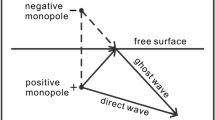Abstract
The South China Sea where water depth is up to 5000 m is the most promising oil and gas exploration area in China in the future. The seismic data acquired in the South China Sea contain various types of multiples that need to be removed before imaging can be developed. However, compared with the conventional reflection migration, multiples carry more information of the underground structure that helps provide better subsurface imaging. This paper presents a method to modify the conventional reverse time migration so that multiple reflections can migrate to their correct locations in the subsurface. This approach replaces the numerical impulsive source with the recorded data including primaries and multiples on the surface, and replaces the recorded primary reflection data with multiples. In the reverse time migration process, multiples recorded on the surface are extrapolated backward in time to each depth level, while primaries and multiples recorded on the surface are extrapolated forward in time to the same depth levels. By matching the difference between the primary and multiple images using an objective function, this algorithm improves the primary resultant image. Synthetic tests on Sigsbee2B show that the proposed method can obtain a greater range and better underground illumination. Images of deep water in the South China Sea are obtained using multiples and their matching with primaries. They demonstrate that multiples can make up for the reflection illumination and the migration of multiples is an important research direction in the future.
Similar content being viewed by others
References
Baysal E, Kosloff D D, Sherwood J W C. 1983. Reverse time migration. Geophysics, 48: 1514–1524
Berkhout A J, Verschuur D J. 2003. Transformation of multiples into primary reflections. Annual International Meeting, SEG, Expanded Abstracts, 73: 1925–1928
Berkhout A J, Verschuur D J. 1994. Multiple technology: Part 2, migration of multiple reflections. 64th, Annual International Meeting, SEG, 64: 1497–500
Brown M P, Guitton A. 2005. Least-squares joint imaging of multiples and primaries. Geophysics, 70: s79–s89
Chang W, Mcmechan G A. 1987. Elastic reverse-time migration. Geophysics, 1365–1375
Clearbout J F. 1968. Synthesis of a layered medium form its acoustic transmission response. Geophysics, 33: 264–269
Guitton A. 2002. Shot-profile migration of multiple reflections. Annual International Meeting, SEG, Expanded Abstracts, 72: 1296–1299
He R, Schuster G. 2003. Least-squares migration of both primaries and multiples. Annual International Meeting, SEG, 73: 1035–1038
Liu Y, Chang X, Jin D, et al, 2011. Reverse time migration of multiples for subsalt imaging. Geophysics, 76: WB209–WB216
Jinag Z, Sheng J, Yu J, et al. 2007. Migration methods for imaging different-order multiples. Geophys Prospect, 55: 1–19
Muijs R, Robertsson J O A, Holliger K. 2007. Prestack depth migration of primary and surface-related multiple reflections: Part II—Identification and removal of residual multiples. Geophysics, 72: S71–S76
Paffenholz J, Mclain B, Zaske J, et al. 2002. Subsalt multiple attenuation and imaging: Observations from the Sigsbee2B synthetic dataset. Annual International meeting, SEG, 72: 2122–2125
Reiter E C, Toks M N, Keho T H, et al. 1991. Imaging with deep-water multiples. Geophysics, 56: 1081–1086
Schuster, T. G, Yu J, et al. 2004. Interferometric/daylight seismic imaging. Geophys J Inter, 157: 838–852
Shan G, 2003. Source-receiver migration of multiple reflections. Annual International Meeting, SEG, 73: 1008–1011
Sheng J. 2001. Migration of multiples and primaries in CDP data by crosscorrelogram migration. Annual International Meeting, SEG, 71: 1297–1230
Vasconcelos I, Snieder R, Hornby B. 2008. Imaging internal multiples from subsalt VSP data — Examples of target-oriented interferometry. Geophysics, 73: S157–S168
Verschuurd D J, BerkhoutA J, 2005. Transforming multiples into primaries: Experience with field data. Annual International Meeting, SEG, 75: 2103–2106
Verschuurd D J, Berkhout A J, Wapenaar C P A. 1992. Adaptive surface-related multiple elimination. Geophysics, 57: 1166–77
Yu J, Schuster G. 2002. Joint migration of primary and multiple reflections in RVSP data. Annual International Meeting, SEG, 72: 2373–2376
Author information
Authors and Affiliations
Corresponding author
Rights and permissions
About this article
Cite this article
Liu, Y., Zhu, W., Mi, L. et al. Migration of multiples from the South China Sea. Sci. China Earth Sci. 58, 482–490 (2015). https://doi.org/10.1007/s11430-014-4952-y
Received:
Accepted:
Published:
Issue Date:
DOI: https://doi.org/10.1007/s11430-014-4952-y



